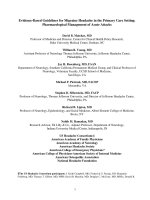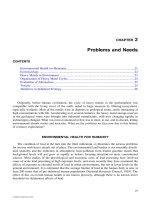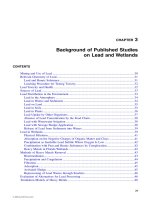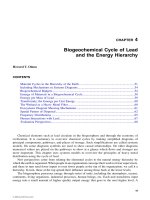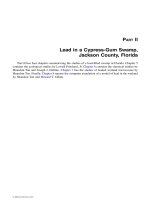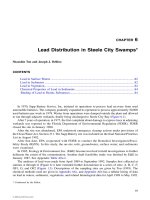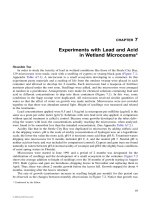Heavy Metals in the Environment: Using Wetlands for Their Removal - Chapter 2 doc
Bạn đang xem bản rút gọn của tài liệu. Xem và tải ngay bản đầy đủ của tài liệu tại đây (321.56 KB, 7 trang )
21
CHAPTER
2
Problems and Needs
CONTENTS
Environmental Health for Humanity 21
Ecotoxicology 22
Heavy Metals in Environment 23
Organization of Heavy Metal Cycles 24
Evaluation of Alternatives 25
Toxicity 25
Initiatives in Industrial Ecology 26
Originally, before human civilization, the cycle of heavy metals in the geobiosphere was
compatible with the living cover of the earth, aided in large measure by filtering ecosystems,
especially wetlands. Most of the metals were in deposits in geological strata, rarely interacting at
high concentrations with life. Accelerating over several centuries, the heavy metal storage reserves
in the geological strata were brought into industrial manufacture, with uses changing rapidly as
technologies changed. What was most economical at first was to mine, to use, and to discard, letting
environments absorb wastes and toxicities. What are the
problems
we face now due to this history
of resource exploitation?
ENVIRONMENTAL HEALTH FOR HUMANITY
The condition of lead at the turn into the third millenium
AD
illustrates the serious problems
for society with heavy metals out of place. The environmental lead burden is not smoothly distrib-
uted spatially, and the reduction in atmospheric lead pollution from leaded gasoline means that
background levels will not grow as rapidly as before, focusing attention on more concentrated
sources. Most studies of the physiological and economic costs of lead poisoning have involved
cases of acute lead poisoning at high exposure levels, and more recently they have examined the
effects of exposure to elevated levels of lead in urban environments, but not at lower levels in the
general environment. It is estimated that the average burden of lead in the human body is now at
least 300 times that of pre-industrial human populations (National Research Council, 1993). The
effect of this on overall human health is not known precisely, although there is no known lower
threshold for deleterious effects of lead.
L1401-frame-C2 Page 21 Monday, April 10, 2000 9:18 AM
© 2000 by CRC Press LLC
22 HEAVY METALS IN THE ENVIRONMENT: USING WETLANDS FOR THEIR REMOVAL
While lead has long been known as a toxin, the last 20 years has confirmed the poisonous
effects of lead for the neurological system, even at very low levels (Needleman et al., 1979, 1990).
Lead levels in human blood as low as 0.1 ppm (10 micrograms per deciliter = 10
µ
g/dl) are now
considered cause for intervention by public agencies such as the Centers for Disease Control (CDC)
and Environmental Protection Agency (EPA) (National Research Council, 1993). Low-level lead
exposure has been linked to lowered intelligence, diminished cognitive function, and delinquent
behavior in children (Schwartz, 1994a; Jacobs, 1996b; Needleman et al., 1996). The sources of
lead exposure have changed in recent years, with the decline of leaded gasoline and lead solder in
food cans, but the largest remaining sources are especially risky for children — lead-based paint
and lead-polluted soil (Jacobs, 1996b).
Lead pollution from leaded gasoline and food cans was much more easily addressed by
environmental regulations than the residual stock of lead in house paint and soil. Manufacturers
of leaded gasoline and tainted foodstuffs could be identified and regulations readily enforced.
Although the use of lead-based paint in houses declined from 1940 onward (National Research
Council, 1993), the danger remains as old paint flakes, crumbles, turns to dust, or is disturbed
by renovation.
The U.S. Department of Housing and Urban Development (HUD) estimated the cost of com-
pletely removing lead-based paint from the nation’s housing stock to be about $500 billion (HUD,
1990, cited in Jacobs, 1996a). (By comparison, EPA estimated the annual cost of removing lead
from gasoline to be only about $500 million.) That cost is misleading, however, since interim
control methods (to reduce exposure but not to remove all lead-based paint) would be much less
expensive. Given the toxic effects of low-level lead exposure discussed above, there are clear
economic benefits to such an enterprise. Schwartz (1994b) estimated a social benefit of $1.7 billion
(1989 dollars) for a 0.1-
µ
g/dl (1.0 ppb) drop in blood lead levels, using methods of neoclassical
economics. Measuring the social benefit of reducing lead exposure using emergy has not been
undertaken, but would be expected to be at least as dramatic.
ECOTOXICOLOGY
There is finally a general realization that humanity can be healthy only when its environment
is also healthy. Understanding heavy metal toxicology also requires an understanding of these
elements and their impact on the environment — the field of ecotoxicology. Some of the questions
about heavy metals and environment are scientific issues about the way systems self-organize their
cycles of toxic material use.
Twenty scientists gave their views on this field in a book entitled
Ecotoxicology, a Hierar-
chical Approach
(Newman and Jagoe, 1996). Starting with the very small scale of cells and
molecular biology, chapters considered the processing of toxic substances by organisms and their
behavior, populations, communities, ecosystems, lakes, and the earth as a whole. Newman, in
his introduction, defines the field as: “knowledge about the fate and effects of toxicants in
ecosystems based on explanatory principles.” But mechanisms at a small scale of time and space
(example: chemical reactions) cannot by themselves explain distributions at much larger scales.
Principles were not included for relating separate chapters on phenomena of different scale. A
discipline is sometimes defined as understanding phenomena of a particular scale (example:
chemistry concerned with molecules and their processes), but it is unlikely that principles of one
scale can suffice.
In Chapter 4 of this book we try to relate phenomena of different scales using energy hierarchy
concepts. Emergy (spelled with an “m”) is a quantitative measure of the work accumulated in
concentrating valuable substances from one scale to another. Units and processes are given their
hierarchical position by their unit emergy, which increases with scale and concentration and
correlates with toxicity (Genoni and Montague, 1991). Systems models are required which combine
L1401-frame-C2 Page 22 Monday, April 10, 2000 9:18 AM
© 2000 by CRC Press LLC
PROBLEMS AND NEEDS 23
what is important among the scales of interest. In this book a systems model of lead in a wetland
is simulated in Chapter 8.
Much science in this century has approached each phenomenon of interest by studying com-
ponent mechanisms one scale smaller or more. In
Ecotoxicology, a Hierachical Approach
most of
the chapters discuss various mechanisms of toxic interaction at the smaller scales of stressed
organisms. This is the traditional approach of trying to understand all the component mechanisms
even though the larger-scale parts of the system and flow in the biogeochemical cycles are con-
trolling the rates. If the questions and needs are environmental, is it really necessary to understand
the DNA damage, molecular biology, membrane physiology, histology, organism behavior, popu-
lation demography, ecosystem oscillations, biogeography, and community composition (the topics
of the ecotoxicology book)? It is probably not practical to put that much detail from the parts in
a model intended to explain the environmental role of heavy metals.
Minimodels
are simplifications in the form of diagrams and mathematical equations relating
the various parts and processes of a system. For example, Beyers and Odum (1993) simulated the
role of a toxic metal that recirculates through the photosynthesis and respiration of an ecosystem,
with a generalized minimodel named TOXICPR. Another model of a cycle of toxic substance
(named TOXICOSM) simulated the stress on biodiversity. These are top-down models, highly
aggregated to show only the most important components and processes. How useful are minimodels
of this class in explaining heavy metal distribution in real cases?
Ecological microcosms
are containers with living, miniaturized ecosystems (examples: aquaria
and terraria). Perez et al. (1977) and Perez (1995) studied similar treatments in microcosms of
three different sizes and found that the impacts were dependent on the size of the microcosm.
Large-scale impact oscillations were excluded from the small scale. Questions were raised about
using small microcosms to judge toxicity impact of large environmental systems. Beyers and Odum
(1994) reviewed some of the extensive literature that used ecological microcosms to study cycles
and toxicities. In this review we suggested transferring conclusions from small-scale microcosms
to larger-scale systems by multiplying the dimensions of the observed phenomena’s time, space,
and unit emergy by the scaling factor relating microcosm to the full-scale system. Underlying this
theory is the general systems idea that processes of all scales are similar because of the energy
principles guiding self-organization.
HEAVY METALS IN ENVIRONMENT
Other questions concern the way the lead cycle is changing in its relationship to society. What
do we need to know to set public policy on heavy metals?
1.
How can human society reorganize the toxic impacts of heavy metals?
People can avoid
concentrations of the heavy metals such as those in acid drainages and hot-spring waters around
volcanoes. The principal toxic exposures now are leftovers from unwise uses of heavy metals in
close proximity to people. The lead use in pipes started in Roman times. The tetraethyl lead that
was an “antiknock” gasoline additive spread lead with motor vehicle exhausts on all the roadsides.
With passage of the Clean Air Act of 1972, lead emissions from automobiles began to decrease in
the U.S., and the lead concentrations in transportation decreased dramatically (Eisenreich et al.,
1986). The action needed to stop uses that are not compatible with life and human society is well
under way.
2.
Can heavy metal accumulations be made safe from human interaction including the natural
ore deposits and industrial waste sites?
Currently there are toxic distributions and accumulations
from the rush to use heavy metals in the past. These include mines left open to the surface waters
and aquatic ecosystems. They include Superfund sites like the Sapp Swamp in this study. Digging
up the metal residues and soils and putting them in a dump somewhere else is not a solution.
Getting the biogeochemical cycle on a track to become part of the geological cycle of slow and
L1401-frame-C2 Page 23 Monday, April 10, 2000 9:18 AM
© 2000 by CRC Press LLC
24 HEAVY METALS IN THE ENVIRONMENT: USING WETLANDS FOR THEIR REMOVAL
more isolated processes is the appropriate course of action. Processing Superfund wastes through
regular technological metal reprocessing was recommended by Staley (1996).
3.
When can we increase the fraction of heavy metals supplied from reuse?
Well under way are
the collection and return of heavy metals for reprocessing and resupply. This saves the earth reserves
and closes the cycles, preventing environmental accumulations (Chapter 3). Florida, for example,
requires lead, nickel, and cadmium batteries to be recycled for reprocessing, not cast into general
solid waste disposal systems.
4.
Can the rate of use be balanced with a sustainable rate of supply?
Although recycling for
reuse was substantial in 1997, the rate of use of ores of lead and other heavy metals was not
sustainable. As the more concentrated ores become increasingly scarce, prices will rise, and more
and more of the metals will have to come from recycle and reuse at greater cost. Then the former
great economic stimulus of cheap abundant raw materials will be over. Decreasing availability of
cheap critical materials and the rising costs of fuels will contribute to the leveling and decline of
the global economy.
5.
Can society eliminate the dangerous concentrations of heavy metals left over from earlier
ill-advised uses?
For example, lead-based paint, crumbling into dust from old houses, is dan-
gerous if ingested, especially by children playing on the ground or on the floors. Lead paints
have been banned from use in houses since 1978, and laws now require checks and information
to be supplied in real estate transactions. Public health recommendations call for checking for
lead in children.
ORGANIZATION OF HEAVY METAL CYCLES
6.
Is there an energetic principle of chemical self-organization that accounts for the natural
distribution of the heavy metals?
The tendency for heavy metals to circulate and become concen-
trated high in the energy hierarchy of the earth and of the economy is related to energy and emergy
(spelled with an “m”) in Chapter 4. Many of the heavy metals of the earth are concentrated into
ore bodies, the result of converging processes of the energy hierarchy of the global system.
According to this concept, position in the energy hierarchy determines real wealth value, and
justifies costs in processing and the kind of reuse or recycle that is appropriate.
7.
How does the precivilization cycle of heavy metals compare with the present cycle?
Appar-
ently, the earlier system kept lead and other heavy metals bound in cycles of the land, keeping
levels in the atmosphere, lakes, and oceans low. Is global toxicity ultimately due to letting heavy
metals get into atmospheric and aquatic circulation?
8.
How can the use and processing of heavy metals by the economy make use of the natural
principles guiding scarce elements?
Public policies on mining and scarce minerals now are largely
guided by short-range economic markets. Emergy and emdollars are used in Chapters 4 and 11 as
a better basis for evaluating and planning society’s use of scarce metals in the long range. Alter-
natives are recommended that maximize the production and use of real wealth.
9.
What incentives help consumers recycle and reuse heavy metals?
Already, deposits are being
required to facilitate returns for recycling, as in war times and earlier times of less affluence. Tax
exemptions can be offered to the public based on emdollar values of recycle and reuse. The high
value to the public of keeping the metals in appropriate reuse and out of the air and water cycles
justifies public subsidy. Emergy-emdollar evaluations indicate how much is appropriate.
Incentives can also be used to help the natural processes regulate the environmental recycling.
Conservation and special-use easements can be purchased where lands and waters need to be
managed for the public interest and safety. For example, a public easement can be purchased so
that a wetland containing heavy metals is not excavated. Special restriction easements are less
expensive than outright land purchase; they allow private interests to use lands and waters for
compatible purposes.
L1401-frame-C2 Page 24 Monday, April 10, 2000 9:18 AM
© 2000 by CRC Press LLC
PROBLEMS AND NEEDS 25
EVALUATION OF ALTERNATIVES
10.
Can the real-wealth value (emergy) of heavy metals be given an equivalent economic basis?
Emdollars
are the dollars of the gross economic product made possible by an emergy contribution.
Emergy values in solar emjoules are divided by the emergy/money ratio from Figure 1.9 to obtain
emdollars. Chapter 4 contains examples of emdollar evaluation of lead.
11.
Can we define what is the appropriate best use for scarce chemical elements?
For any need,
a desirable policy selects alternatives that achieve objectives with the least use of the most valuable
materials. Here the emergy value measures of the accumulated work of nature and humans are
better than the market values for measuring which resources are most valuable and scarce, to be
used sparingly. See Chapter 4.
12.
How does the worth of scarce metals compare to strategic needs and safety of nations? On
what basis can policies be defined for conservation?
Resources essential to military prowess and
security were stockpiled during World War II, but used to accelerate the economy after the war.
Both practices need to be put on a comparative basis. Economic use and defense contributions can
both be evaluated on an emergy-emdollar basis, thus representing the real-wealth value to the
public. Emdollar values of heavy metals are much higher than market values. A student report by
Pat Dalton in 1986 found emdollars of defense about twice the economic value, partly because of
the high transformities of strategic metals.
13.
Can we evaluate the present and potential role of wetlands and other natural filters in
environmental self-regulation?
The discovery that many wetlands capture and denature toxic sub-
stances raises the possibility that safety for human society can be achieved with little cost by letting
nature’s ecosystems work for society as they have worked for the biogeosphere in the past. Chapters
11 and 12 evaluate examples. Also see Ton et al. (1998).
14.
How can the useful properties of peat for maintaining a healthy biosphere be evaluated
when economic profit evaluations appear to justify destructive uses?
Lynne (1984) had difficulty
finding any method of economic analysis that would prevent the nonrenewable use of Florida peats
for agriculture. Odum (1996) found the Santa Fe Swamp in North Florida was worth 1.6 billion
emdollars to the public, much more than if the peat were sold at market price. This evaluation used
emergy procedures, which are based on the work contributed by nature. See Chapter 4.
TOXICITY
15.
Can measurement of heavy metals in the pore waters of sediments represent the tendency
for metals to be toxic to organisms or to be released to open waters?
Pore water analysis is a recent
approach to determining the hazard of sediments containing heavy metals (Campbell and Tessier,
1996). For example, they report an experiment by Ankley et al. (1991) that correlated mortality of
benthic amphipods to the ratio of heavy metal to AVS (acid volatile sulfides). The idea is that more
metal relative to potentially binding sulfide means more metal free to affect the animals. Yet there
are many binding mechanisms in sediments and wetlands (particle adsorption, base exchange,
complexing with humic acids, precipitation). Are binding mechanisms complementary so that there
are usually backup mechanisms to bind heavy metals not bound by the first process?
16.
How should acute toxicity tests (mortality in a short time — <96 h) and chronic toxicity
tests (mortality over a long period — >96 h) be used to manage lead in the environment?
Whereas
acute tests can quickly determine dangerous levels, should they ever be used for Environmental
Quality standards (EQ)? The time scale of human lives is much longer, and the time for accumulating
impact is greater than for short-lived test animals. Being on a larger scale, humans are more sensitive
to some stresses, such as ionizing radiations, than other species of plants, animals, and microbes.
17.
Can emergy per unit mass and/or transformity (the emergy per unit energy) be used to
predict toxicity of substances?
Energy hierarchy theory finds the effect of something increasing
L1401-frame-C2 Page 25 Monday, April 10, 2000 9:18 AM
© 2000 by CRC Press LLC
26 HEAVY METALS IN THE ENVIRONMENT: USING WETLANDS FOR THEIR REMOVAL
with its transformity (Chapter 4). Emergy per unit increases with scarcity, possibly because scarcity
is an evidence of more embodied work (and thus higher emergy per unit). An old pharmacological
principle states that drugs that are most beneficial are also the most toxic at the wrong dose. In a
sense, environmental pollution is a state of materials in the environment in the wrong dose. Does
greater potential impact (for good or harm) occur when transformity of substance and interacting
receiver differ by one or two orders of magnitude? The smaller impact of toxic substances on small
microcosms compared to large ones may be an example.
18.
Can present concepts of heavy metal risk be put on a simpler and more general basis using
emergy?
The complex concepts of risk now in use to judge heavy metals in the environment evaluate
“probabilities” of metal concentration, probabilities of sensitive organisms being present, and
probabilities of the interests of society being impacted (Suter, 1993). Perhaps emergy and emdollars
can evaluate a potential impact and thus rank priorities and reorganize the use systems to convert
impacts into benefits.
19.
What index of overall ecosystem condition is the best indicator of stress due to heavy metals?
Indices of diversity of plants and animals have been consistent in indicating pollution. See, for
example, diversity of diatoms growing on slides in streams (Patrick, 1949), Bender (1973) using
graphs of species vs. individuals, and a review by Cairns (1977), who finds biodiversity a measure
of ecological integrity. Many papers find lower species diversity with increasing heavy metals.
There is toxic action, but also an effect of helping those species that are adapted to the heavy metals
to prevail and dominate. For example, a heavy monoculture of
Scenedesmus
grew on a copper plate
in Silver Springs, FL, rather than the high diversity periphyton growing on glass slides. See
microcosm examples reviewed elsewhere (Beyers and Odum, 1993).
INITIATIVES IN INDUSTRIAL ECOLOGY
Industrial ecology
is a recently popular word for initiatives from private industry to develop a
stable and efficient system of material use and recycle. Socolow et al. (1994) say the goal of
industrial ecology is “evolution of the world’s industrial activity into suitable and environmentally
benign systems.”
20.
Can industries such as battery makers take over the whole cycle of processing, use, reuse,
and control of environmental recycle?
In our time many people seek to privatize many public needs.
Can the private industries that now produce heavy metal products take over the whole cycle of a
heavy metal including recycle, reuse, and safe control of environmental releases? The products are
at the high value end of the cycle, and incentives are provided by market prices and demand for
use. Recycled remnants and wastes are at the more dispersed part of the cycle where there is little
market demand or source of money. To manage privatizing for the public good may require emergy-
based economic subsidies or tax incentives for the dilute part of cycles.
21.
How will changes in automobile transportation affect heavy metal use and environmental
impact?
Urban growth in the 1990s meant more cars, more air pollution, and more consideration
of alternatives to the heavy lead batteries. The Paul Scherrer Institute (1998) compared the electrical
energy per unit mass (watt hours per kilogram) from new, lighter-weight batteries. Older lead
batteries delivered about 35, nickel–cadmium batteries 55, nickel–hydride 76, and zinc–air batteries
100. A net emergy evaluation (which includes changed monetary costs) is needed to see if the
lighter batteries can be a net benefit. With an industrial ecology perspective Graedel and Allenby
(1998) document the central role of automobiles in our civilization. They found the lead batteries
still with the least cost ($70 to 100 /kWh). A switch in metals would change the kind of heavy
metals impacting the environment, but those most considered are all filtered by wetlands.
Will electric cars increase heavy metal risks and costs? Is this transportation sustainable? A
Carnegie-Mellon University study by Lave et al. (1995) on “environmental implications of electric
cars” stated that electric car mandates like one proposed in California may expose thousands of
L1401-frame-C2 Page 26 Monday, April 10, 2000 9:18 AM
© 2000 by CRC Press LLC
PROBLEMS AND NEEDS 27
people to toxic doses of lead while unnecessarily accelerating the demise of an important non-
renewable resource (Berriman, 1995). Lead released with an electric car system was stated to be
larger than the former releases by leaded gasoline. (See rebuttal letters in
Science
, 1995, 269:
741–742.) Previous evaluations of electric cars indicated they were not a net benefit and thus not
likely to prevail (McGrane, 1993).
22.
What is the pattern of heavy metal use and processing appropriate and economical for a
time of less fuel availability and contracting economy?
For the future, what is the long-range
scenario for use of metals? Will there be a climax accumulation of people and machines on the
earth, followed by decreases as the fuel energy basis for the high concentrations decreases? What
are the heavy metal
needs
?
When the shortages of nonrenewable resources force the global economy to a lower level, will
the uses of heavy metals be less? Will there be more conservation and reuse, with diminishing
environmental toxicities? An evaluation of global fuel reserves by Campbell (1997) estimates fuel
prices generally rising after the year 2009.
Initiated by Georgescu-Roegen (1977) is the idea that civilization could become limited more
by the critical materials, such as heavy metals, than by the fuels. However, ecosystems concentrate
critical materials several orders of magnitude as needed so long as they have their energy budget.
In our society more and more fuel energy is being used to recycle, reconcentrate, and reuse the
heavy metals as the concentrations available for mining diminish. Emergy evaluation allows energy
reserves and reserves of critical materials to be compared on an equivalent basis. Both types of
nonrenewable resources are supporting the ultimate pulse of this civilization now under way.
With the questions of this chapter in mind, consider next some of the published literature on
heavy metals and environment in Chapter 3.
L1401-frame-C2 Page 27 Monday, April 10, 2000 9:18 AM
© 2000 by CRC Press LLC

